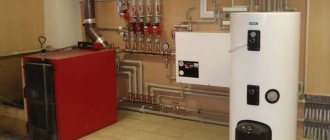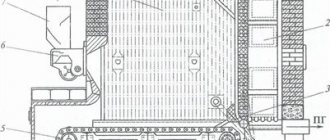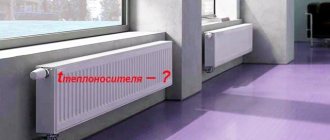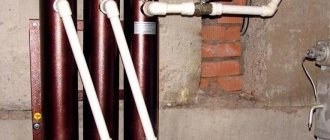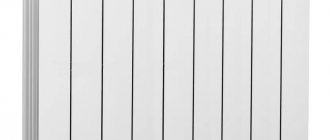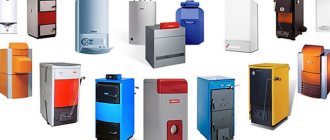Weak boiler power will ruin everything, including the standard of living. Due to excess power, the system will operate in impulses: fuel consumption will increase, and the service life of the equipment will be shortened. The boiler may boil. Or brains. How to calculate correctly, what parameters to take into account, what heat loss is and other customer questions about boiler power can be read here.
How to easily calculate the power of a heating boiler?
You can calculate the approximate power of a boiler for a home by area and volume .
1) A simplified version of calculations by area : 10 kW per 100 m² of a house (or heated area). And this figure will only show the minimum power, below which you cannot fall.
| Graph of boiler versus area |
To take into account climatic zones, coefficients have been developed that correct this formula:
- Central Russia is 1-1.5;
- Northern regions are 1.5-2;
- Southern territories – 0.7-0.9;
- Moscow and Moscow region – 1.2-1.5.
To get closer to a realistic figure, you also need to take into account possible heat loss. To do this, add 10-15% to the minimum value. If the ceilings are higher than 2.7 meters, then we divide the actual ceiling height by the standard height. We get another correction factor.
| Vacation home |
Example:
Let's calculate the power of a boiler for a house in the Moscow region. Ceilings – 3 meters, area – 150 m². A double-circuit boiler is needed - for heat and hot water supply.
The formula gives 15 kW - the minimum power value for the future boiler. Next, to the number 15 we add 10% of heat loss, multiply by the climate coefficient 1.2. The ceilings are higher than 2.7m, so we multiply the resulting figure by a factor of 1.1.
Boiler power = 15 kW (minimum) + 10% (heat loss) * 1.2 * 1.1 = 21.7, rounded to 22 kW.
2) Second formula based on volume : 1 m3 – 40 W. Plus the markups that were included in the first formula, except for the ceiling coefficient. Let's calculate the same house in the Moscow region using this formula.
Boiler power =((150 m²*3m)* 40 W + 10%) * 1.2 * 1.1 =23522 W ≈ 24 kW. The difference between the first and second calculations is 2 kW. The option of calculating boiler power by air volume is the most correct.
You could stop reading this article here. But the difference between an approximate and an exact calculation is in several nuances. What are the nuances, you ask. The answer to this question is contained in the following paragraphs.
The simplest formula for calculating the required heat energy for heating
For an approximate calculation, there is an elementary formula: W = S × Wsp, where
W is the power of the unit;
S is the size of the building area in m², taking into account all rooms for heating;
Wsp is a standard indicator of specific power that is used when calculating in a specific climatic region.
The standard power density value is based on experience with a variety of heating systems.
The average statistical information is obtained from a housing and communal services employee in your region. After this, multiply this value by the total area of the building, and you will get the average required boiler power.
Calculation example
Gas is the most common type of fuel. How to calculate the power of a gas boiler? Let's consider an example calculation for a building with an area of 150 m², which is presumably located in the Krasnoyarsk Territory. The calculation was made for a heating system with natural circulation without constant pressure from the pump. The specific power in the region under consideration is 0.90 kW/m².
150 m² / 10 m² = 15 is an intermediate calculation coefficient, which implies that 1 kW of the unit’s thermal power is required for an individual 10 m² of heated room area.
15 × 0.90 kW/m² = 13.5 kW.
As a result, the average value of thermal energy required for a specific building with average thermal insulation and climatic indicators was obtained.
If we take into account the use of hot water for the bathroom and kitchen, it will be necessary to add at least 20% to the power: 13.5 + 13.5 × 0.2 = 16.2 kW.
It is worth paying attention to the fact that the pressure in the boiler and the heating main may be unstable; for this it is necessary to add another 15% to the power: 16.2 + 13.5 × 0.15 = 18.225 kW. Considering that a certain leakage of thermal energy cannot be avoided, it is necessary to round the result up
It turns out that to ensure heating of a particular building using a gas fuel heating unit, you will need a boiler with a minimum power of 19 kW
Considering that a certain leakage of thermal energy cannot be avoided, it is necessary to round the result up. It turns out that to ensure heating of a particular building using a heating unit using gas fuel, you will need a boiler with a minimum power of 19 kW.
https://youtube.com/watch?v=dhs2tcez0Kw
Power calculations for gas-fueled units are most often performed during building planning. The reason for this is that the project initially included the location of heating appliances, openings for air exchange, a chimney, as well as a separate room for a heating installation.
If you need to think about heating in an existing building that does not have the necessary conditions for placing a gas-fueled unit, you will need to install an alternative heating system. An electrical installation is well suited for its role, the power of which is calculated using similar calculations.
In addition to the above calculations, the thermal power of the boiler can be calculated using a calculator specially created for this purpose. It includes parameters such as the total area of the room, its height, type of windows, etc. To find out the thermal power, you need to enter the required indicators into the program, having first found out their exact value.
Calculating the required power to heat a private house is not such a difficult task, especially if you use a calculator program. Anyone who wants to save money and provide optimal heating without wasting heat energy can handle it.
What parameters, besides volume and area, influence the choice of boiler? And why is this important?
A simplified calculation formula often leads to the purchase of an unsuitable boiler. Each house is individual, and heat loss percentage cannot be equal for all houses. Before calculating power, consider the data of a specific house:
1) Measure the area of walls, windows, doors;
2) Specify the thickness of the walls, indicate the type of finishing and material, the height of the ceilings;
3) Observe the minimum temperature of the house in cold weather;
4) Determine the desired temperature as a result of installing the boiler;
5) Write down the thermal conductivity values for the materials from which the house was built.
| Wall material | Wall thickness and material thermal resistance | Required thickness for home |
| Brick (1600 kg/m³ - density) | 510 mm (if laying two bricks), R=0.73 °C m²/W | 1380 mm 2190 mm |
| Wooden beam | 150 mm, R=0.83 °С m²/W | 355 mm 565 mm |
| Expanded clay concrete (1200 kg/m³ - density.) | 300 mm, R=0.58 °С m²/W | 1025 mm 1630 mm |
| Wooden panel (inside filled with mineral wool + 25 mm layer of inner and outer cladding) | 150 mm, R=1.84 °С m²/W | 160 mm 235 mm |
| Arbolit | 0.80-0.17W/m² | — |
| Foam concrete | 0.14-0.38 W/m² | — |
| Aerated concrete | 0.18-0.28 W/m² | — |
Thermal resistance of materials
Why is this necessary? The key parameter influencing the choice of boiler is the heat loss of the house. Houses with the same area and volume, but different degrees of insulation, will require equipment of different power.
Where does the heat go:
| Surface | Heat loss in% |
| Roof and ventilation | 20-25% |
| Foundation, if it is adjacent to the ground | up to 15% |
| Walls, windows and doors | 10-15% |
| Ground floor and unheated rooms, basement, for example | up to 15% |
It also matters: how different the outside temperature is from the inside, the climatic region, the strength and direction of the wind, how the house stands relative to parts of the world.
| Heat loss |
Performance reserve depending on the type of boiler
For a standard single-circuit boiler, regardless of the type of fuel used, we always recommend a power reserve of 15-25%, depending on the temperature in the coldest decade and the insulation of the house. However, in some cases a slightly larger margin is required:
- 20-30% reserve if the boiler is double-circuit. Most models operate on the principle of DHW priority, which means that at the moment the hot water consumption point is activated, the boiler does not heat the heating circuit; to operate on two circuits, higher performance is required;
- 20-25% of the reserve if supply and exhaust ventilation without heat recovery is organized or planned in the house.
A scheme with the connection of an indirect heating boiler is also often used (especially in conjunction with solid fuel boilers). In this case, excess capacity may exceed 40-50% (the figure is calculated according to the situation). It is worth understanding that in any of the cases, the provided reserve is not “idle”, but is used whether for the purpose of heating hot water, replenishing higher heat losses, or heating a buffer tank.
The tall white tank to the right of the boiler is an indirectly heated storage boiler that constantly maintains a large volume of hot water.
How to calculate power taking into account heat loss?
What is heat loss? Let’s say it’s -20 degrees outside, but the average temperature at home is +20 degrees. These quantities are balanced through the exchange of energy. Heat losses occur. The amount of heat loss under severe weather conditions helps to calculate the boiler power with high accuracy.
Step 1
Heat loss is determined by the formula: Q = Q roof + Q walls + Q floor + Q doors + Q windows .
Where the extreme value of Q is the heat loss of each surface of the house.
Each Q value is calculated using the formula: Q = S * T / R
Where Q is heat loss in W, S is the area of a specific surface in m², T is the difference between street and room temperatures in degrees, R is reference data on thermal resistance by type of material.
Step 2
This formula additionally includes involuntary heat loss through cracks, ventilation, exhaust hoods, opening doors and ventilation through windows. For independent calculations without a program, an additional 5% of the total leakage figure is added.
Step 3
Next we move on to determining the boiler power. There are only two formulas to choose from:
Rkot. = ( S room * P beat ) / 10 , where Rkot. — boiler power, Sroom. - the total area of rooms in the house where heating is planned, Pud. — specific power according to climate conditions.
Rkot. = ( Q losses * S from area ) / 100, where Rkot. - boiler power, Qloss - heat loss, Sot. area – total area of heated rooms.
Step 4
For an electric and gas boiler, you can use the table to check:
| Option | House area, m² | Heating, kW | Recommended number of devices | How many people live | DHW boiler, l/kW | Warm floor, m² | Warm floor, kW | Total power | Boiler power | Standard range of boilers, Cat, Ns/A/Nd |
| 1 | 2 | 3 | 4 | 5 | 6 | 7 | 8 | 9 | 10 | 11 |
| 2 | 150 | 19 | 10 | 4 | 100/28 | 16 | 0,75 | 48 | 28 | 28/27/28 |
| 3 | 200 | 22 | 11 | 4 | 100/28 | 20 | 1 | 51 | 28 | 28/27/28 |
| 4 | 250 | 25,5 | 17 | 4 | 160/33 | 20 | 1 | 60 | 33 | 32/35/36 |
| 5 | 300 | 27 | 20 | 6 | 160/33 | 30 | 1,5 | 62 | 34 | -/35/36 |
| 6 | 350 | 31 | 26 | 6 | 200/33 | 40 | 2 | 66 | 39 | -/44/44 |
| 7 | 400 | 4 | 30 | 6 | 200/36 | 50 | 2,5 | 70 | 43 | -/44/44 |
| 8 | 450 | 36 | 44 | 8 | 300/36 | 60 | 3 | 75 | 45 | -/53/52 |
We take into account heat loss
Let us note that regardless of whether the power of an electric boiler, a gas boiler, a diesel boiler or a wood boiler is calculated, in any case, the operation of the heating system will be accompanied by heat losses:
- Ventilation of the premises is necessary, but if the windows are constantly open, the house will lose about 15% of energy.
- If the walls are poorly insulated, then 35% of the heat will be lost.
- 10% of the heat will escape through the window openings, and even more if the frames are old.
- If the floor is not insulated, then 15% of the heat will be transferred to the basement or ground.
- 25% of the heat will escape through the roof.
Before calculating the heating boiler, it should be taken into account that if at least one of these factors occurs, then this should be reflected in the calculations.
Heat loss at home
Why count if you can buy a boiler with a power reserve?
Sometimes boilers have a capacity reserve. This is good when the reserve is no more than 25%. Especially when the family plans to develop the area: complete a swimming pool, sauna, or other heated area. When the required power is exceeded significantly, the owner spends extra money, and the equipment operates in abnormal mode:
| Boiler repair |
- Breaks or malfunctions;
- The efficiency of the system decreases;
- A higher power boiler costs more;
- More fuel is consumed than is required to heat the house;
- A more powerful and expensive pump will be needed;
- The house will be very hot;
- Automatic regulation becomes difficult, the boiler may boil;
- The boiler begins to cycle - it turns on and off in a short period of time, equipment components wear out;
- Condensation appears in the chimney. When burned, the condensate reacts with the emissions and produces acid. It destroys the chimney and sometimes the boiler.
Conclusion: frequent switching on and off wastes more fuel than continuous operation. Buying a boiler with excess power not only makes no sense, but is also harmful to the budget and equipment.
How to solve the problem of high power and weak demand?
In an ideal situation, the boiler operates at a constant, rated output. At the same time, the outside temperature is constantly changing, and there are even abnormal jumps. What to do? Four-way mixing valves in the hydraulic system will help. Or an option with thermo-hydraulic distribution. These devices solve the problem not by adjusting the boiler power, but by adjusting the control valve. Or the speed of the circulation pump changes. The temperature of the coolant in the batteries becomes comfortable without disturbing the optimal conditions of the boiler. This solution has a minus - a high price.
| Four way mixing valve |
For gas and liquid fuel boilers, multi-stage burners solve this situation. A lower stage reduces the boiler power if necessary. Advanced models have a smooth adjustment of burner power - modulation. It is cheaper and not as troublesome as the first option.
| Multi-stage gas burner |
Solid fuel boilers also have built-in power settings and automatic fuel supply. This helps solve the issue of excess power when the external temperature changes.
| Automatic fuel supply device for liquid-heat boiler |
What to follow
When asked how to choose a heating boiler, they often answer that the main criterion is the availability of a particular fuel. In this context, we will highlight several types of boilers.
Gas boilers
Gas boilers are the most common types of heating equipment. This is due to the fact that fuel for such boilers is not very expensive and is available to a wide range of consumers. What types of gas heating boilers are there? They differ from each other depending on what type of burner is atmospheric or inflatable. In the first case, the exhaust gas goes through the chimney, and in the second, all combustion products escape through a special pipe using a fan. Of course, the second version will be a little more expensive, but it will not require smoke removal.
Wall-mounted gas boiler
As for the method of placing boilers, the choice of heating boiler involves the presence of floor and wall models. Which heating boiler is better in this case - there is no answer. After all, everything will depend on what goals you are pursuing. If, in addition to heating, you need to supply hot water, then you can install modern wall-mounted heating boilers. This way you won’t need to install a boiler to heat the water, and this will save money. Also, in the case of wall-mounted models, combustion products can be discharged directly onto the street. And the small size of such devices will allow them to fit perfectly into the interior.
The disadvantage of wall-mounted models is their dependence on electrical energy.
Electric boilers
Next, we will consider electric heating boilers. If there is no mains gas in your area, an electric boiler can save you. These types of heating boilers are small in size, so they can be used in small houses, as well as in cottages with an area of 100 sq.m. All combustion products will be harmless from an environmental point of view. And installation of such a boiler does not require special skills. It is worth noting that electric boilers are not very common. After all, fuel is expensive, and its prices are rising and rising. If you are asking which heating boilers are better in terms of economy, then this is not an option in this case. Very often, electric boilers serve as backup heating devices.
Solid fuel boilers
Now it’s time to consider what solid fuel heating boilers are available. Such boilers are considered the most ancient; such a system has been used for heating premises for a long time. And the reason for this is simple - fuel for such devices is available, its quality can be firewood, coke, peat, coal, etc. The only drawback is that such boilers are not able to operate in autonomous mode.
Gas generating solid fuel boiler
A modification of such boilers is gas generator devices. This boiler differs in that it is possible to control the combustion process, and the productivity is regulated within the range of 30-100 percent. When you are thinking about how to choose a heating boiler, you should know that the fuel that such boilers use is wood, and their humidity should not be less than 30%. Gas fired boilers depend on the supply of electrical energy. But they also have advantages over solid fuel ones. They have high efficiency, which is two times higher than solid fuel devices. And from the point of view of environmental pollution, they are environmentally friendly, since combustion products will not enter the chimney, but will serve to generate gas.
The rating of heating boilers shows that single-circuit gas generator boilers cannot be used for heating water. And if we consider automation, it is great. You can often find programmers on such devices - they regulate the temperature of the coolant and give signals if there is an emergency.
Gas generator boilers in a private home are an expensive pleasure. After all, the cost of a heating boiler is high.
Liquid fuel boilers
Now let's look at liquid fuel boilers. Such devices use diesel fuel as a working resource. To operate such boilers, you will need additional components - fuel containers and a room specifically for the boiler. If you are thinking about which boiler to choose for heating, then we note that liquid fuel boilers have a very expensive burner, which can sometimes cost as much as a gas boiler with an atmospheric burner. But such a device has different power levels, which is why it is profitable to use it from an economic point of view.
In addition to diesel fuel, liquid fuel boilers can also use gas. For this purpose, replaceable burners or special burners are used that can operate on two types of fuel.
Liquid fuel boiler
What happens if you buy a boiler of lower power?
When the owner made a mistake with the power on the smaller side, this is just as bad as an oversupply. The system is working at its limit. Service life is reduced. The house is not heated sufficiently; the system may freeze during abnormal frosts.
| Freezing of the heating system |
Some general information - what is the required amount of heat?
Very briefly, all this is already known - it just requires a little systematization.
For a modern person to live comfortably, he requires the creation of a certain microclimate, one of the most important components of which is the air temperature in the room. And although “thermal preferences” may vary, we can safely say that for most people this “temperature comfort” zone lies in the range of 18–23 degrees.
But when there is, for example, a negative temperature outside, then natural thermodynamic processes tend to bring everything under the “common bar”, and heat begins to leave the living area. Heat loss is a completely normal phenomenon from a physical point of view. The entire housing insulation system is aimed at minimizing such losses, but it is impossible to completely eliminate them. And hence the conclusion - heating the house is precisely intended to make up for these same heat losses.
There is no escape from heat losses, but it is very important to at least try to reduce them to the possible minimum
How to determine their quantity?
The simplest way to calculate the required heating power is based on the statement that 100 watts of heat are required for each square meter of area. Or - 1 kW per 10 m².
But even without being an expert, you can think about how such “equalization” is combined with the specifics of specific houses and the premises in them, with the placement of buildings on the ground, with the climatic conditions of the region of residence?
So it is better to use a different, more “scrupulous” calculation method, which will take into account many different factors. It is this algorithm that is the basis of the calculator proposed below.
Important - calculations are carried out for each heated room of a house or apartment separately. And only at the end the total amount of required thermal energy is calculated
The easiest way would be to create a small table, the rows of which list all the rooms with the data necessary for calculations. Then, if the owner has a plan of his residential property at hand, the calculations will not take much time.
And one more note. The result may seem quite exaggerated. But we must understand correctly - in the end, the amount of heat that is required to replenish heat loss in the most unfavorable conditions is shown. That is, to maintain the indoor temperature of +20 ℃ at the lowest outdoor temperatures characteristic of the region of residence. In other words, at the peak of winter cold the house will be warm.
But such super-frost weather, as a rule, lasts for a very limited time. That is, the heating system will mostly operate at a lower power. This means that there is no particular point in laying down any additional reserve. The operational power reserve will be already impressive.
Below is a calculator, and below it will be placed the necessary brief explanations for working with the program.
Why contact a specialist?
We found out that buying a boiler from the square is wrong. It is important to consider the heat loss of the building. For example, a house of 300 m² can be heated by a 15 kW boiler if all surfaces are thoroughly insulated. And a house of 150 m² may require 30 kW equipment with thin walls and uninsulated roof and ventilation.
There are hundreds of standards and regulations on this topic, there are dozens of formulas. Sometimes one thing contradicts the other, or standards change and it is difficult for a non-professional to understand whether these requirements are relevant. You can calculate all this armed with a stack of reference books. Or contact specialists who will make accurate calculations in the program and explain all the details. They will help you save money, time, and model an efficient home heating system.
Concept of dispersion coefficient
This is a constant indicator that does not change when it is necessary to calculate the level of heat exchange of building structures. But the latter must be constructed from the same building material.
| Building type | Dissipation coefficient |
| Modern with insulated structures: walls, roofing, floors | 0,6-0,9 |
| Roof and walls insulated | 1,0-1,9 |
| Brick buildings without insulation | 2,0-2,9 |
| Concrete buildings without insulation | 3,0-4,0 |
Despite the apparent simplicity of the calculation, it is necessary to understand that much depends on the design of the building.
Is it complex or simple. The simpler the house, the less complicated it is to calculate the power of a gas boiler. Therefore, it is worth seeking help from specialists. How to choose the power of a gas boiler: video.
Maybe someone will tell you in the comments how the gas boiler was selected? Was its power taken into account when choosing? Save the article in your bookmarks so as not to lose useful information and calculation formulas.

